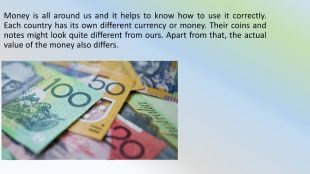Презентація "Money around the world"
Про матеріал
Презентація "Money around the world" для учнів старших класів. Матеріл містить інформацію про 8 різних валют з картинками. Перегляд файлу
Зміст слайдів
pptx
Оцінка розробки


Безкоштовний сертифікат
про публікацію авторської розробки
про публікацію авторської розробки
Щоб отримати, додайте розробку
Додати розробку




















